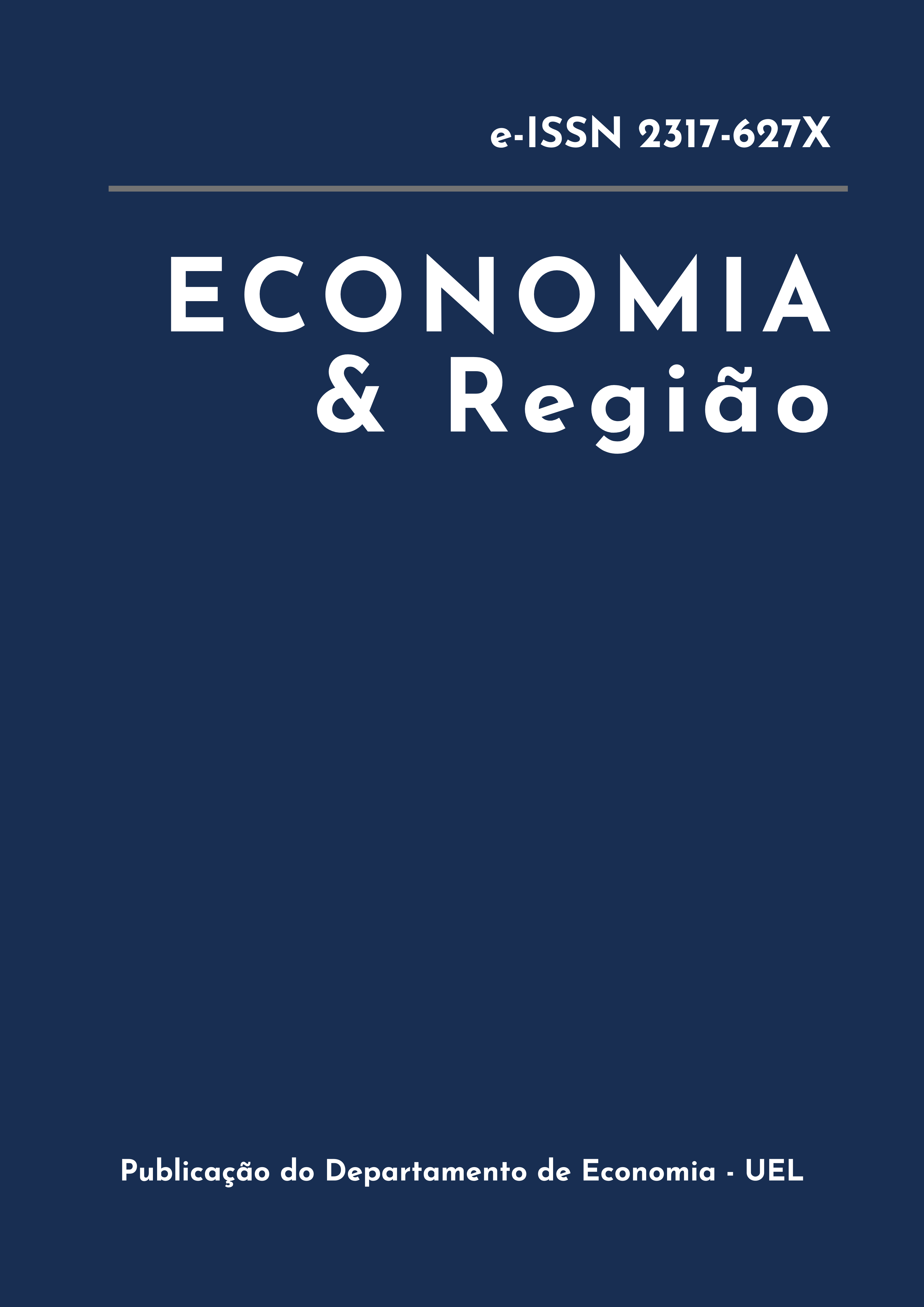A MAUP e os efeitos da diversidade industrial na estabilidade econômica regional brasileira
DOI:
https://doi.org/10.5433/2317-627X.2024.v12.n3.49941Palavras-chave:
diversidade industrial, estabilidade econômica, MAUP, escalas geográficas, econometria espacialResumo
A correlação entre diversidade industrial e estabilidade econômica regional é defendida teoricamente como sendo positiva, indicando que uma região que possui uma maior diversificação industrial sofre uma menor interferência de choques exógenos, resultando em uma menor instabilidade econômica. Entretanto, historicamente trabalhos empíricos encontram resultados divergentes, muitas vezes não sendo observada uma significância na correlação. Dentre os possíveis motivos que podem levar a tal divergência, há o Problema de Unidade de Área Modificável (MAUP), foco deste trabalho. O modelo de econometria espacial empregado foi estimado com dados da RAIS e do Censo Demográfico em nível de municípios, microrregiões e mesorregiões brasileiras para os anos de entre 2010 e 2019. Os resultados indicam uma influência espacial em todos os níveis geográficos e apontam para uma variação na magnitude, significância e no sinal da correlação a depender da escala de agregação espacial utilizada, confirmando a hipótese do MAUP no estudo. Além disso, o nível municipal foi o único que apresentou resultados mais coerentes com a teoria no caso brasileiro.
Downloads
Referências
ANSELIN, Luc. Spatial econometrics: methods and models. Springer Science & Business Media, 1988.
ANSELIN, Luc. Interactive techniques and exploratory spatial data analysis. 1996.
ANSELIN, Luc. Under the hood issues in the specification and interpretation of spatial regression models. Agricultural economics, v. 27, n. 3, p. 247-267, 2002.
ANSELIN, Luc. Spatial externalities, spatial multipliers, and spatial econometrics. International regional science review, v. 26, n. 2, p. 153-166, 2003.
ATTARAN, Mohsen. Industrial diversity and economic performance in US areas. The Annals of Regional Science, v. 20, n. 2, p. 44-54, 1986.
CARVALHO, A.; DA MATA, Daniel; RESENDE, Guilherme Mendes. Clusterização dos municípios brasileiros. Dinâmica dos municípios, p. 326-368, 2007.
CHEN, Jing. Economic Diversity and Regional Development: Geographical Scale, Structural Measurement, and Modeling Method. West Virginia University, 2018.
CHEN, Yanguang. New approaches for calculating Moran's index of spatial autocorrelation. PloS one, v. 8, n. 7, p. e68336, 2013.
CHINITZ, Benjamin. Contrasts in agglomeration: New york and pittsburgh. The American Economic Review, v. 51, n. 2, p. 279-289, 1961.
CONROY, Michael E. The concept and measurement of regional industrial diversification. Southern Economic Journal, p. 492-505, 1975.
DARK, Shawna J; BRAM, Danielle. DARK, Shawna J.; BRAM, Danielle. The modifiable areal unit problem (MAUP) in physical geography. Progress in physical geography, v. 31, n. 5, p. 471-479, 2007.
DÍAZ DAPENA, Alberto; FERNÁNDEZ VÁZQUEZ, Esteban; RUBIERA MOROLLÓN, Fernando. Labor density and wages in Spain: Evidence from geographically disaggregated data. Growth and Change, v. 49, n. 1, p. 55-70, 2018.
DELLER, Steven; WATSON, Philip. Spatial variations in the relationship between economic diversity and stability. Applied Economics Letters, v. 23, n. 7, p. 520-525, 2016.
DE VREYER, Philippe; SPIELVOGEL, Gilles. Spatial externalities between Brazilian municipios and their neighbours. IAI Discussion Papers, 2005.
DISSART, Jean Christophe. Regional economic diversity and regional economic stability: research results and agenda. International Regional Science Review, v. 26, n. 4, p. 423-446, 2003.
ELHORST, J. Paul et al. Spatial econometrics: from cross-sectional data to spatial panels. Heidelberg: Springer, 2014.
GLEASER, Edward L. et al. Growth in cities. Journal of political economy, v. 100, n. 6, p. 1126-1152, 1992.
GOODCHILD, Michael F. Scale in GIS: An overview. Geomorphology, v. 130, n. 1-2, p. 5-9, 2011.
GOODCHILD, Michael F. et al. Toward spatially integrated social science. International Regional Science Review, v. 23, n. 2, p. 139-159, 2000.
HONG, Saheum; XIAO, Yu. The influence of multiple specializations on economic performance in US Metropolitan Areas. Sustainability, v. 8, n. 9, p. 963, 2016.
KEINATH JR, William F. The spatial component of the post-industrial society. Economic geography, v. 61, n. 3, p. 223-240, 1985.
KELEJIAN, Harry H.; PRUCHA, Ingmar R. A generalized spatial two-stage least squares procedure for estimating a spatial autoregressive model with autoregressive disturbances. The journal of real estate finance and economics, v. 17, p. 99-121, 1998.
KORT, John R. Regional economic instability and industrial diversification in the US. Land Economics, v. 57, n. 4, p. 596-608, 1981.
KRUGMAN, Paul. Increasing returns and economic geography. Journal of political economy, v. 99, n. 3, p. 483-499, 1991.
KRUGMAN, Paul. Urban concentration: the role of increasing returns and transport costs. International Regional Science Review, v. 19, n. 1-2, p. 5-30, 1996.
KRUGMAN, Paul. What's new about the new economic geography?. Oxford review of economic policy, v. 14, n. 2, p. 7-17, 1998.
LESAGE, James P. The theory and practice of spatial econometrics. University of Toledo. Toledo, Ohio, v. 28, n. 11, p. 1-39, 1999.
LESAGE, J.; PACE, R. Introduction to spatial econometrics. crc press, boca raton. Introduction to spatial econometrics, v. 1, p. 01, 2009.
MALIZIA, Emil E.; KE, Shanzi. The influence of economic diversity on unemployment and stability. Journal of Regional Science, v. 33, n. 2, p. 221-235, 1993.
MIZUNO, Keizo; MIZUTANI, Fumitoshi; NAKAYAMA, Noriyoshi. Industrial diversity and metropolitan unemployment rate. The Annals of Regional Science, v. 40, p. 157-172, 2006.
NEVES, Mateus de Carvalho REIs; CASTRO, Lucas Siqueira de; FREITAS, Carlos Otávio de. O impacto das cooperativas na produção agropecuária brasileira: uma análise econométrica espacial. Revista de Economia e Sociologia Rural, v. 57, p. 559-576, 2019.
OPENSHAW, Stan. The modifiable areal unit problem. Concepts and techniques in modern geography, 1984.
PORTER, Michael E. The competitive advantage of nations The Free Press. New York, v. 564, 1990.
PUGA, Diego; VENABLES, Anthony J. The spread of industry: spatial agglomeration in economic development. Journal of the Japanese and International Economies, v. 10, n. 4, p. 440-464, 1996.
RESENDE, Guilherme Mendes. Multiple dimensions of regional economic growth: The Brazilian case, 1991− 2000. Papers in Regional Science, v. 90, n. 3, p. 629-662, 2011.
SIEGEL, Paul B.; JOHNSON, Thomas G.; ALWANG, Jeffrey. Regional economic diversity and diversification. Growth and change, v. 26, n. 2, p. 261-284, 1995.
SOUZA, Helson Gomes de et al. Uma análise espacial de como o crescimento e a desigualdade afetam a pobreza no Brasil. Revista de Administração Pública, v. 55, p. 459-482, 2021.
TOBLER, Waldo R. A computer movie simulating urban growth in the Detroit region. Economic geography, v. 46, n. sup1, p. 234-240, 1970.
TRENDLE, Bernard; SHORNEY, Gianna. The effect of industrial diversification on regional economic performance. Australasian Journal of Regional Studies, v. 9, n. 3, p. 355-369, 2003.
WAGNER, John E. Regional economic diversity: action, concept, or state of confusion. Journal of Regional analysis and policy, v. 30, n. 1100-2016-90005, 2000.
WAGNER, John E.; DELLER, Steven C. Measuring the effects of economic diversity on growth and stability. Land Economics, p. 541-556, 1998.
WATSON, Philip; DELLER, Steven. Economic diversity, unemployment and the Great Recession. The Quarterly Review of Economics and Finance, v. 64, p. 1-11, 2017.
Downloads
Publicado
Como Citar
Edição
Seção
Licença
Copyright (c) 2024 Vinicius Hiago e Silva Gerônimo, Marcelo de Oliveira Torres

Este trabalho está licenciado sob uma licença Creative Commons Attribution 4.0 International License.
Economia & Região adota a Licença Creative Commons Attribution CC-BY 4.0 International, portanto, os direitos autorais relativos aos artigos publicados são do(s) autor(es), que cedem à Revista Economia & Região o direito de exclusividade de primeira publicação.
Sob essa licença é possível: Compartilhar - copiar e redistribuir o material em qualquer suporte ou formato. Adaptar - remixar, transformar, e criar a partir do material, atribuindo o devido crédito e prover um link para a licença e indicar se mudanças foram feitas.




















